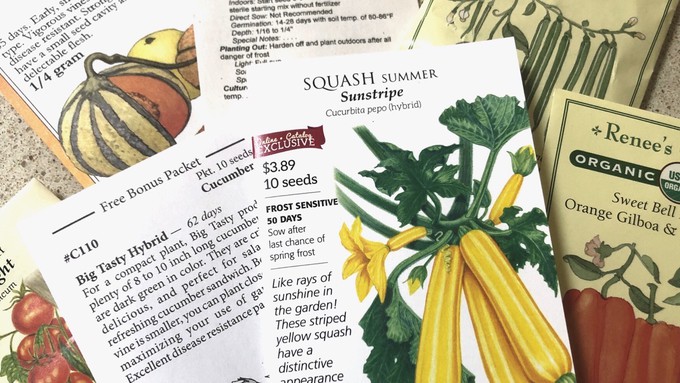
Organize your own local swap for Jan. 28

Get those excess seeds working in someone else’s garden — swap them! Kathy Morrison
It’s a January gardener preoccupation: Seed shopping. Whether browsing catalogs or online websites, we are constantly tempted by “new and improved” or “best ever” varieties as well as vegetables or flowers we’ve never seen before.
The result? Quite often, we accumulate too many seeds! It's time to do some seed swapping.
Saturday, Jan. 28, is National Seed Swap Day, a coast-to-coast gardener initiative to get more seeds and gardens growing.
To be held on the last Saturday of each January, National Seed Swap Day was launched by Washington Gardener magazine, a mostly online publication dedicated to gardening in the nation’s capital and surrounding areas. It has an official website, https://seedswapday.blogspot.com/, which lists upcoming seed swaps and encourages others to share their unwanted (or unplanted) packets.
National Seed Swap Day is local and totally grassroots. Gardeners in any kind of group – community garden, club, church, neighborhood, work, etc. – set a time and place, then bring their excess seeds. They can break down a packet (do you really need 30 of the same tomato variety?) or trade last season’s seeds that are still viable. Seeds are packed fresh for each season for maximum germination rate, but most vegetable, herb and flower seeds remain viable for at least two or three years.
It’s likely other gardeners will appreciate those seed swap offerings.
U.S. nurseries and seed distributors are still catching up with record demand for garden seeds. During the pandemic, major seed houses such as Peaceful Valley Organic sold out of almost all their stock, frustrating many gardeners.
According to the National Garden Bureau, seed customers should find better inventory this season – but get your orders in early – then be patient.
“Seed companies are likely to experience delays in times of high demand so be aware of that company’s current timeline for shipping,” advises the bureau. “They will be transparent. Sign up for or subscribe to that company’s communications to stay informed and up-to-date.”
Seed demand is expected to remain high all year, says the bureau, so go ahead and order your fall seeds now along with seeds for spring and summer planting.
“Don’t buy just for spring because succession sowing is important for season-long harvest and there are wonderful vegetables like cabbage and kale that are great for fall plantings,” the bureau says.
For more about seeds and seed shopping, check out these tips from the National Garden Bureau: https://ngb.org/2021/01/28/ask-the-experts-about-seedfacts/.
For more on National Seed Swap Day: https://seedswapday.blogspot.com/.
Comments
0 comments have been posted.Sacramento Digs Gardening to your inbox.
Food in My Back Yard Series
May 6: Maintain soil moisture with mulch for garden success
April 29: What's (already) wrong with my tomato plants?
April 22: Should you stock up on fertilizer? (Yes!)
April 15: Grow culinary herbs in containers
April 8: When to plant summer vegetables
April 1: Don't be fooled by these garden myths
March 25: Fertilizer tips: How to 'feed' your vegetables for healthy growth
March 18: Time to give vegetable seedlings some more space
March 11: Ways to win the fight against weeds
March 4: Potatoes from the garden
Feb. 25: Plant a fruit tree now -- for later
Feb. 18: How to squeeze more food into less space
Feb. 11: When to plant? Consider staggering your transplants
Feb. 4: Starting in seed starting
Sites We Like
Garden Checklist for week of May 11
Make the most of the lower temperatures early in the week. We’ll be back in the 80s by Thursday.
* Plant, plant, plant! It’s prime planting season in the Sacramento area. Time to set out those tomato transplants along with peppers and eggplants. Pinch off any flowers on new transplants to make them concentrate on establishing roots instead of setting premature fruit.
* Direct-seed melons, cucumbers, summer squash, corn, radishes, pumpkins and annual herbs such as basil.
* Harvest cabbage, lettuce, peas and green onions.
* In the flower garden, direct-seed sunflowers, cosmos, salvia, zinnias, marigolds, celosia and asters. (You also can transplant seedlings for many of the same flowers.)
* Plant dahlia tubers.
* Transplant petunias, marigolds and perennial flowers such as astilbe, columbine, coneflowers, coreopsis, dahlias, rudbeckia and verbena.
* Keep an eye out for slugs, snails, earwigs and aphids that want to dine on tender new growth.
* Feed summer bloomers with a balanced fertilizer.
* For continued bloom, cut off spent flowers on roses as well as other flowering plants.
* Add mulch to the garden to maintain moisture. Mulch also cuts down on weeds. But don’t let it mound around the stems or trunks of trees or shrubs. Leave about a 6-inch-to-1-foot circle to avoid crown rot or other problems.
* Remember to weed! Pull those nasties before they set seed.
* Water early in the day and keep seedlings evenly moist.